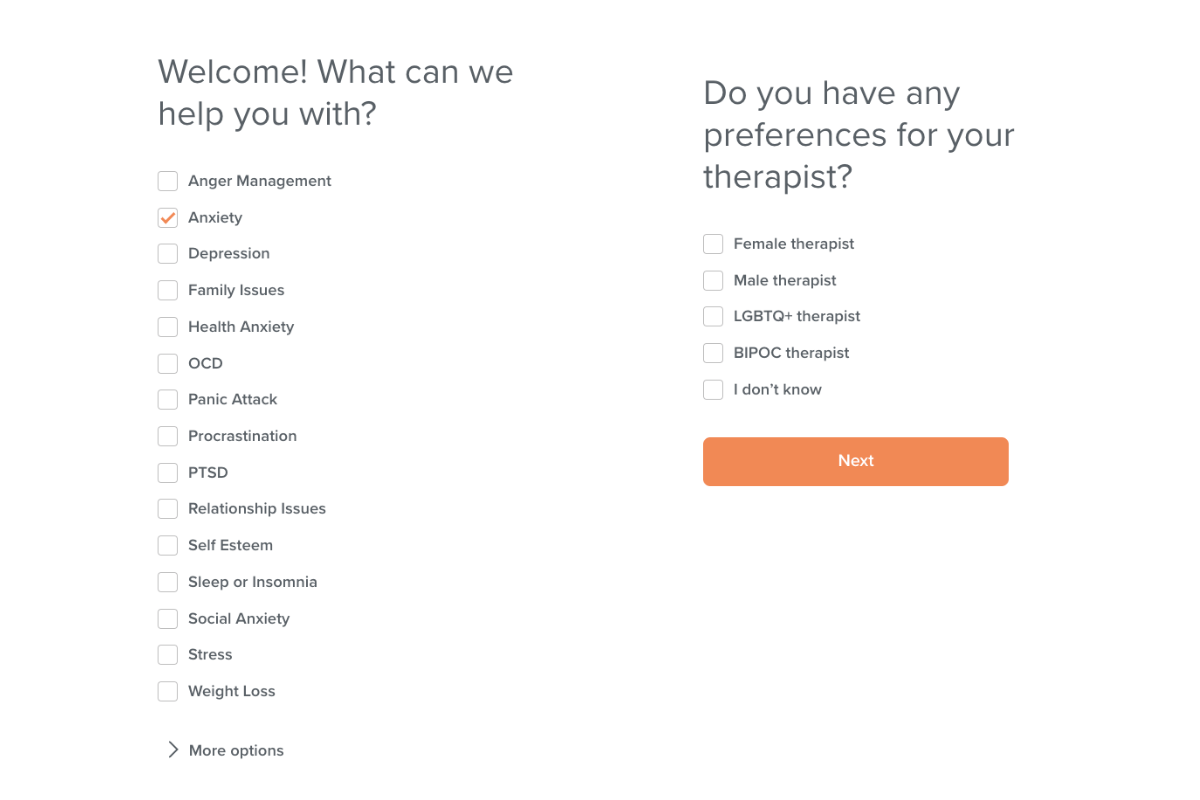Table of Contents
- Our Review Team spent over 7,500 hours researching more than 70 online therapy platforms. Our testers signed up for the 14 most popular platforms to get first-hand experience.
- We surveyed over 1,200 online therapy users, held focus group interviews with both users and therapists, and consulted with more than 60 mental health experts.
- Our testers evaluated Online-Therapy.com for four weeks, signing up for the platform, attending sessions, and switching therapists to assess provider availability.
Learn more about how we tested Online-Therapy.com
Key takeaways
- We recommend Online-Therapy.com to individuals interested in committing to 8 weeks of an online cognitive behavioral therapy program that promotes practical and positive changes.
- Online-Therapy.com does not accept insurance, but their standard therapy package costs $320. This competitive price includes four 45-minute live therapy sessions and unlimited messaging-based therapy.
- Online-Therapy.com stood out to testers because all therapists are trained in cognitive behavioral therapy, and the platform provides additional support resources like worksheets and journal prompts.
For our Online-Therapy.com review, we aimed to discover what makes this platform stand out amongst other online platforms. One of the most notable differences is that Online-Therapy.com specifically takes a cognitive behavioral therapy approach. Cognitive behavioral therapy (CBT) is a solutions-focused treatment that helps you change negative thought patterns and behaviors for good. This approach aims to help reduce the impact of negative thought patterns and worries.
All providers on the Online-Therapy.com platform are CBT-trained, and the program is designed using CBT principles. Our Handbook Team personally tested the platform to learn how its CBT-focused program works. Read our review to see if this is the best online therapy option for your needs.

Online-Therapy.com highlights
Our final verdict on Online-Therapy.com
Online-Therapy.com is an online therapy platform with flexible scheduling and affordable self pay rates.The therapists at Online-Therapy.com are all trained in cognitive behavioral therapy, or CBT, and we think this platform is suited for individuals who are interested in making practical, solution-oriented changes in their day-to-day life.
While this platform doesn’t accept insurance, they are among the more affordable self-pay online therapy options, with plans starting at $200 per month.
Who should consider Online-Therapy.com: Online-Therapy.com is a good choice for individuals looking for flexible and affordable therapy that focuses on practical and positive changes.
Who should consider other options: If you are looking for online therapy covered by insurance, or if you have a mental health condition requiring more intensive care, Online-Therapy.com may not be a good fit for you.
What is Online-Therapy.com?
The Handbook Team testers found Online-Therapy.com beneficial for motivated adults and couples wanting to make lasting changes. The platform provides a complete program based on the principles of cognitive-based therapy (CBT), a therapeutic approach designed to help people identify and change negative thinking patterns and unhelpful behaviors. Studies have shown CBT to be an effective treatment for many mental health conditions, including depression and anxiety. Internet-delivered CBT has also been shown to be effective for patients with a variety of psychiatric conditions.
All of Online-Therapy.com’s therapists are trained in CBT methods, and CBT tools like journals and self-reflective worksheets are included in all plans, which is why we rated it as best on our review of the best CBT platforms. We like that CBT is integrated throughout the platform, though our testers found the degree to which therapists follow the CBT program may vary.
While Online-Therapy.com offers users a comprehensive therapy plan, they do not offer psychaitry services. If you would benefit from psychiatric care, check out our carefully vetted list of the best online psychiatry platforms.
The individuals who are best served by CBT are the ones who are motivated to improve the habits of thinking and acting that work against them as well as open to seeing faulty patterns. It’s not easy to enter treatment and face things that cause distress, but we often sense that we are capable of more peace, more achievement, more joy, if we do.
Itala Azzarelli, LCSW, ACDCS
How does Online-Therapy.com work?
Online-Therapy.com is committed to a structured, cognitive behavioral therapy program that all providers follow. Online-Therapy.com is a web-based program. They do not have an app, but we found their website to be mobile-friendly. Once you are assigned to a therapist, they will guide you through sections of the program using live, once-a-week phone or video sessions supported by worksheets, journaling, and yoga videos.
One of Online-Therapy.com’s best features is how easy it is to start your therapy journey. Within 30 minutes, you can set up an account, get matched with a therapist, and even switch to a new therapist with more compatible availability. We also found the platform easy to use and navigate. “I appreciate that I don’t need to download a specific app to use it. I can just log in from my browser,” one tester notes.
Another benefit of Online-Therapy.com is its affordability. Though the platform doesn’t take insurance, its basic plan is the most affordable of any online therapy platform we’ve reviewed. Also, the platform makes it easy to apply for financial aid—just indicate your need in the sign-up process. One tester received a 30 percent discount after answering a few questions about employment status, dependents, and income. Financial aid approval was immediate.
How to sign up for Online-Therapy.com online therapy
1. On the website’s main page, click “Individual Therapy (for me)” or “Couples Therapy” (for us).” You’ll then be guided through a series of questions about your areas of concern, your age and gender identity, the therapist identity you prefer, and the type of session you prefer (video, voice only, text message therapy, or unsure).

2. Create an account and choose your subscription plan. Plans start at $40 per week for your first month with the platform’s introductory offer (20 percent off your first month). The most affordable plan includes texting with your therapist but no live sessions.
3. Gain access to all of Online-Therapy.com’s therapy tools, including an eight-section CBT program, worksheets, a digital journal, an activity plan accountability tool, and yoga and meditation videos. Once you begin meeting with your therapist, you can continue working with the CBT tools between sessions.

4. Begin communicating with the therapist you were matched with. Sessions can take place via phone, live video, or text. “I had to immediately switch therapists to find one that could offer therapy during a time that worked for me,” says one Handbook Team tester who chose live video sessions. She described the process of switching therapists as “fairly easy.”
How to match with an online therapist
After the initial sign-up, which includes a basic intake, our tester matched with a therapist. They noted that at this point, they had only answered three questions about their preferred provider, gender, and mental health conditions, which they checked off a provided list. While there was the option to write in additional mental health issues, our tester didn’t feel this was taken into account.
From one of our testers
“The therapist the platform selected for me only had available appointment slots between 5am and 6am PST. I had to immediately switch therapists to find one that could offer therapy during a time that worked for me.”
Based on the limited availability of the therapist they were paired with, our tester didn’t feel their schedule was considered during the matching process. Because this therapist wasn’t in the same time zone as our tester, finding appointment times that worked for her was especially challenging. Online-Therapy.com also had limited openings during her most convenient times, such as after regular work hours.

Live video sessions
During live video sessions, we found the sessions productive and practical, meeting our expectations overall based on previous experiences with therapy. That being said, we did leave these sessions with a few concerns.
During testing, the website was not accessible to our tester’s microphone and camera and they were encouraged to leave the session and re-enter. While they had knowledge necessary to change their audio and video permissions, Online-Therapy.com didn’t provide instructions. We feel this might be difficult for someone with limited experience with technology.
Additionally, one of our testers reported background noise during their session, indicating that another person was nearby. We feel this raises concerns about privacy, especially since this specific provider wasn’t wearing headphones. Later, they learned their provider was working from a home office, but the privacy concerns were not addressed.
Live chat sessions
In addition to live video and phone sessions, Online-Therapy.com offers live chat sessions. This feature is different from the unlimited messaging option included in the most basic plan, which is not live. Live chat sessions are just that, they replace 45-minute video and phone sessions and take place on the messaging portal on the website at a pre-scheduled appointment time.
Online-Therapy.com’s CBT resources
The Handbook Team likes the platform’s CBT focus, as did our testers. The eight-section CBT program is self-guided, though you can receive some feedback from your therapist. For example, your therapist is notified when you complete a worksheet, and you should receive a reply within 24 hours. It’s worth noting that it may take some motivation to make it through every section of the program. One tester described the sections as “dense, long-form reading” similar to a textbook, though audio and video versions are also available.
A tester also found that the program’s CBT tools weren’t mentioned in any of her sessions, which made her feel less motivated to use the tools on her own. “If you love CBT as part of your therapy,” she says, “bring this up with your therapist so they can direct you to resources and tell you how they recommend you interact with the platform’s tools.”
What other users are saying
In our October 2023 survey of 600 online therapy users, 57 percent of Online-Therapy.com users chose virtual therapy because it offered more flexibility in scheduling, with appointments available on evenings and weekends. Flexible appointment times may make therapy more accessible and possibly even more effective, as session frequency is associated with faster improvement of symptoms.
In the same survey, we learned that 35 percent of Online-Therapy.com users had their first appointment with a provider in less than one day (33 percent reported waiting less than one week for their first appointment). Forty-one percent of users stayed with the same Online-Therapy.com provider for one to six months, while 14 percent stayed with a provider for seven to 12 months.
How much does Online-Therapy.com cost?
Online-Therapy.com offers three price points for individual therapy, with the standard therapy plan costing $320 a month. The basic plan is only $200 a month, making this an affordable online therapy option. This price is similar to BetterHelp’s, which is between $260 and $360, depending on your location and provider availability. If you’re interested in comparing the two services, learn more in our BetterHelp review.
| Online-Therapy.com subscription plan | Cost per month | Included services | What to know |
|---|---|---|---|
| Basic plan | $200 | Unlimited messaging with provider and CBT plan. | No live sessions included in this plan. For women with anxiety, text-based CBT could help reduce symptoms. |
| Standard plan | $320 | Weekly live video sessions, unlimited messaging with providers, and CBT plan. | This is Online-Therapy.com’s most popular plan. |
| Premium plan | $440 | Two weekly live video sessions, unlimited messaging with providers, and CBT plan. | Twice-weekly sessions could help decrease depressive symptoms, especially in the early months of therapy. |
Is Online-Therapy.com covered by insurance?
Online-Therapy.com is not covered by insurance. However, we found it to be one of the more affordable self-pay online therapy options, and it could be a choice for someone without mental health coverage included in their therapy plan. If you have insurance coverage and hope to use it, we found several high-quality platforms for online therapy that take insurance.
How to save money on Online-Therapy.com
During testing, we learned that Online-Therapy.com offers financial assistance. We filled out their application, which was short and non-invasive, and one of our testers was quickly approved for a 30 percent discount on their monthly plan.
Our experience with Online-Therapy.com customer service
After one of our testers determined their provider to be a poor fit based on schedule availability and experience, we contacted the customer service department over email, the only contact option at Online-Therapy.com. Unfortunately, even though the response time was minutes after the initial email sent, they failed to follow up on the exact details of our tester’s mental health concern. This prevented them from finding a provider who was a good fit.
If you have a highly specific mental health issue you would like to address, a platform with a larger number of practitioners may be a better fit. In our BetterHelp review, you can learn more about the services provided by their 30,000 therapists.
Our Online-Therapy.com testing experience
We spent over 7,500 hours researching 70 online therapy platforms, ultimately signing up for the 14 most popular platforms. Our testers spent four weeks using these platforms, reporting on their experience after completing their testing. We also surveyed 1,200 online therapy users about their experience, interviewed them, and consulted with mental health experts about which characteristics are most important in a therapy provider.






Our testers explored the Online-Therapy.com platform, attending online therapy sessions for at least four weeks. We carefully noted our experience, beginning with sign-up and continuing to the end of therapy services. Specifically, we kept the following considerations in mind during testing Online-Therapy.com:
- Customer service: During testing, we reached out to this platform’s customer service department. We took note of their responsiveness as well as how thoroughly they provided solutions for our concerns.
- Brand trustworthiness: We conducted independent research on Online-Therapy.com to identify any ethical concerns or lawsuits this brand is involved in.
- Features: Our testers tried any added features and resources available to support live therapy. At Online-Therapy.com, this meant trying out their yoga videos, worksheets, messaging portal, and journal prompts.
- User experience: In addition to surveying users, we read user reviews on third-party websites to see if our experience aligned with the general experience of therapy users.
- Diversity of therapists: We evaluated this platform on its inclusivity and diversity of practitioners. During testing, we looked for options allowing users to filter therapists by ethnicity or gender identity.
- Affordability: We compared the cost of services at Online-Therapy.com with other online therapy brands and the average cost of mental health services.
Compare Online-Therapy.com to other online therapy platforms
When compared to other online therapy platforms, Online-Therapy.com stands out in some areas while falling short in others. For example, their practical, structured CBT program is more solutions-oriented than other brands. Their 45-minute sessions are longer than the similarly priced 30-minute sessions our testers experienced, as detailed in our Talkspace review. However, as we point out in our BetterHelp review, there are online services with a greater number of therapists and more schedule flexibility than Online-Therapy.com.
| Monthly cost for individual therapy | $200–$440 | $260–$400 | $276–$436 | $95–$349 | Varies by provider; typical insurance copay is $30 or less |
| Accepts insurance? | No | No | Yes | Yes | Yes |
| Can prescribe a controlled substance?* | No | No | No | No | Yes |
*Physicians’ ability to prescribe controlled substances without an in-person visit varies by state. Commonly prescribed psychiatric controlled substances include Xanax, Klonopin, or Valium (sometimes prescribed for anxiety; and Adderall or Ritalin (sometimes prescribed for ADHD).
Our final verdict
We like Online-Therapy.com’s CBT focus and appreciate the bonus features included in your subscription, including yoga videos and a digital journal. Though Online-Therapy.com doesn’t take insurance, its services are affordable, with plans starting at $200 per month. This platform is ideal for people who are eager to make positive changes and have the time and motivation to complete the eight-part CBT program in addition to attending live sessions.
Frequently asked questions
To get started with Online-Therapy.com, select the type of therapy you want on its main page (individual or couples). Then, answer a few questions about your identity and preferences, create an account, and choose a monthly subscription. The platform will match you with a provider, though it’s always okay to switch providers.
Online-Therapy.com does not accept insurance, but it does offer financial aid.
Yes. All Online-Therapy.com providers are licensed mental health providers with verified credentials.
- Hofmann, Stefan G., Asnaani, A., Vonk, I. J. J., Sawyer, A. T., & Fang, A. (2012). The Efficacy of Cognitive Behavioral therapy: A review of Meta-analyses. Cognitive Therapy and Research, 36(5), 427–440. Link
- Gratzer, D. & Khalid-Kahn, F. (2016). Internet-delivered cognitive behavioural therapy in the treatment of psychiatric illness. Canadian Medical Association Journal, 188(4). Link
- Tiemens, B., Kloos, M., Spijker, J., Ingenhoven, T., Kampman, M., & Hendriks, G. (2019). Lower versus higher frequency of sessions in starting outpatient mental health care and the risk of a chronic course; a naturalistic cohort study. BMC Psychiatry, 19(1). Link
- Da Luz Dias, R., Shalaby, R., Agyapong, B., Vuong, W., Gusnowski, A., Surood, S., Greenshaw, A. J., & Agyapong, V. I. O. (2023). The effectiveness of CBT-based daily supportive text messages in improving female mental health during COVID-19 pandemic: results from the Text4Hope program. Frontiers in Global Women’s Health, 4. Link
- Bruijniks, S. J. E., Hollon, S. D., Lemmens, L. H. J. M., Peeters, F. P. M. L., Arntz, A., Cuijpers, P., Twisk, J., Dingemanse, P., Willems, L., van Oppen, P., van den Boogaard, M., Spijker, J., & Huibers, M.J.H. (2023). Long-term outcomes of once weekly v. twice weekly sessions of cognitive behavioral therapy and interpersonal psychotherapy for depression. Psychological Medicine, (54)3. Link










